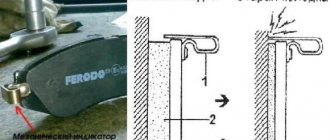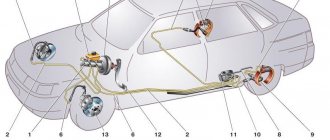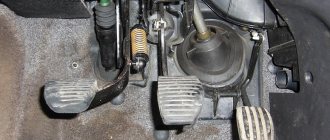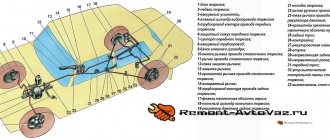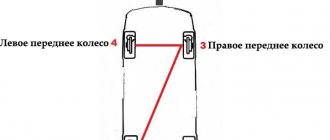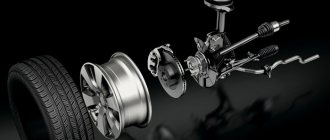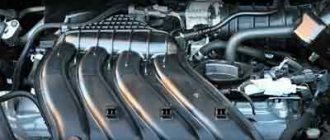Like any car, the IS also has problems that often become a puzzle for the average car mechanic.
This time the problem was the brake system malfunction indicator (a light indicating that the hand brake has been lifted). It lights up and doesn't go out. We started looking at the handbrake, thinking that the button was stuck. No, when you lift it, a beep appears, which means the chip and the button are ok. Next we checked the brake fluid level - NORMAL. When the methods of “scientific poking” ended, they took us to the master. Without hesitation, the master plugged in the computer and fiddled around, but couldn’t find anything. His conclusion was as follows: leave the car so he could ring the wiring, maybe one of the sensors is acting up or the contact is exposed and shorted to something.
This, of course, made me think and go Google, which gave me several reasonable, and most importantly simple, directions for action. By studying circuit diagrams, including electrical circuits, books on car maintenance and other things, as well as by the method of elimination, 4 main possible causes were identified.
So, a simplified version
Problem:
The light on the dashboard is on (and does not go out), indicating a malfunction of the brake system.
Possible reasons:
(if the indicator does not light up when you start the car, but lights up when you press the brake pedal, then most likely you can skip the 1st point) 1. Brake fluid level sensor 2. Brake pad wear 3. Central brake light lamp 4. Button or chip handbrake
Diagnostics:
1. The electrical circuit diagram is designed in such a way (including the structure of the sensor - it gives a signal only when the liquid level is low) that if you disconnect the reservoir sensor chip with the brake, then the comp. will think that the level is normal. Therefore, disconnect the chip, and if the indicator goes out, then the problem is there. 2. If the wear of the pads is very large, the fluid level may drop when pressed and the indicator will light up. 3. If disconnecting the chip (see step 1) did not have any effect, then you probably have this exact problem. Press the brake and see if the central brake light is on. If it doesn't light up, that means it's the problem. 4. With the car running, raise the handbrake, if a sound signal appears, then everything is in order, if there is no sound, it makes sense to look
Why does the indicator ((!)) appear?
The brake system consists of a mechanical part (discs, pads, brake fluid, lines, etc., manual or electric parking brake) and an electronic part - a set of sensors and wiring.
Only on certain car models, signals from different sensors are indicated by the lighting of individual lamps, and then the letter ((P)) on the dashboard indicates that the handbrake is engaged, and the icon ((!)) indicates a malfunction of the main brake system.
Often, cars have only one warning lamp, which receives signals from the brake fluid level sensor, pad wear, brake light and handbrake.
What does the brake system say - indication and its meaning
First of all, this material is not a reprint of car instructions, but our generalized experience. We deliberately omit the situation when the error indicator appears for a few seconds when starting the car and goes out after 3-5 seconds: this is a consequence of self-diagnosis and, accordingly, is normal. A cause for concern is when errors appear on the device for a longer period of time. Since the error icon does not always indicate a direct problem, we will try to include non-critical reasons in the description. And, of course, the nature of the indicators may change from model to model, so our review is general in nature.
First of all, the color of the indicator. Yellow, as a rule, has an informative and warning character, which means you need to start looking for a problem as soon as possible. Red - the problem requires immediate diagnosis and elimination, operation of the car is highly not recommended.
The most basic indicator of an error related to the brake system. The main reasons for the indication include:
- hand brake on
- low brake fluid level
- malfunction of ABS sensors
— wear of the brake pads/rupture of the wear sensor target
— the brake light does not function
Secondary reasons. Most often, the circuit breaks – starting from the terminals of the ABS unit. Another reason is the alarm: incorrect installation or a dead battery in the tag.
Elimination. Start small - make sure the handbrake is released and turned off. Check the brake fluid level in the reservoir and top up if necessary. All other diagnostic methods will have to be delegated to a service station: checking the condition of brake pads, electronic wear sensors, diagnosing ABS systems and other circuits.
— A type of indicator (!). It is found on cars where, in addition to the classic exclamation mark, there are clarifying symbols that more accurately indicate a malfunction. Most often, this is a direct indication of wear on the brake pads (the icon itself indicates whether the car is front or rear axle). However, before rushing to buy a new kit, it is better to diagnose the problem. In particular, such an indicator may flash if the wear sensor breaks.
— Variation for cars with electronic handbrake. Such an icon in some cars is simply not provided as standard, where the role of the indicator is played by the above symbol (!). The error indicates a malfunction of the parking brake - mechanical or electronic. And, of course, the normal activation of the handbrake.
Elimination. If such an indicator does not go out after the car is released from the parking brake, and the movement of the car is essentially blocked, an emergency shutdown option is provided. As a rule, it is enough to pull the drive cable hidden in the passenger compartment or trunk of the car. If you succeed in doing this, go straight to the service center, diagnose and repair the function: a problem with the cable, control unit or parking brake system device.
- Most often, it indicates a problem with the electronics, and not with the brake system itself. Simply put, if one ABS light is on, then your car will brake quite normally, but stabilization systems are unlikely to help you in emergency situations. What does the indicator say? Minimum – broken wiring in the ABS circuit, maximum – electronic system control unit.
Secondary reasons:
— in snowy winter, good slipping can cause an ABS error. After driving onto hard surfaces the error will disappear
— dirt falling on the ABS sensors distorts their readings. After a good wash the indicator will go out.
— the indicator may also light up immediately after a visit to the service station (engaging in gear with the car hanging on a lift). After the first 50-100 meters of vehicle movement, the error will go out.
Troubleshooting: in-depth diagnosis and treatment of the problem based on the diagnosis obtained.
A combination of indicators is also possible. For example, the combination of (!) and (ABS) icons indicates a problem in the braking system, which is caused by a malfunction of the anti-lock braking system.
Basic brake system terms - what do you need to know?
How to define the problem more accurately
If the indicator lights up during hard braking, this is an argument in favor of the version with worn pads. The solution is to replace the pads.
If the light periodically goes out, this may be due to the fact that the liquid splashes in the tank during driver maneuvers, and at some moments its level is below the diagnostic float. The solution is to check the tank and add DOT to the level.
ABS lamp lights up along with the indicator ((!)) , this indicates that the ABS sensor has failed.
On Renault models with an electronic handbrake, the “Brake” lamp may come on due to a faulty parking brake sensor.
Warning icons on the panel
The steering wheel icon can light up in two colors. If the yellow steering wheel is on, then adaptation is required, and when a red image of the steering wheel with an exclamation mark appears, you should already be concerned about the failure of the power steering or power steering system. When the red steering wheel lights up, your steering wheel will probably become very difficult to turn.
The immobilizer icon usually blinks if the car is locked; in this case, the indicator of a red car with a white key signals the operation of the anti-theft system. But there are 3 main reasons if the immo light is constantly on: the immobilizer is not activated, if the tag on the key is not read or the anti-theft system is faulty.
The handbrake icon lights up not only when the handbrake lever is activated (raised), but also in cases where the brake pads are worn out or the brake fluid needs to be topped up/replaced. On a car with an electronic handbrake, the parking brake light may come on due to a glitch in the limit switch or sensor.
The coolant icon has several options and depending on which one is lit, draw conclusions about the problem accordingly. One red lamp with a thermometer scale indicates an increased temperature in the engine cooling system, but a yellow expansion tank with waves indicates a low coolant level in the system. But it is worth considering that the coolant lamp does not always light up at a low level; perhaps there is simply a glitch in the sensor or float in the expansion tank.
The washer icon indicates a low fluid level in the windshield washer reservoir. Such an indicator lights up not only when the level actually decreases, but also if the level sensor is clogged (the sensor contacts become coated due to poor-quality liquid), giving a false signal. On some vehicles, the level sensor is triggered when the washer fluid does not meet specifications.
The ASR icon is an Anti-Spin Regulation indicator. The electronic unit of this system works in tandem with ABS sensors. When such a light is constantly on, it means the ASR is not working. On different cars, such an icon may look different, but often in the form of an exclamation mark in a triangle with an arrow around it or the inscription itself, or in the form of a car on a slippery road.
Catalyst icon
It often lights up when the catalytic element overheats and is quite often accompanied by a sharp drop in engine power. Such overheating can occur not only due to poor cell throughput, but also if problems arise in the ignition system. When the catalyst fails, high fuel consumption will be added to the burning light.
The exhaust gases icon, according to information from the manual, indicates a malfunction in the exhaust gas purification system, but, as a rule, such a light starts to light after poor refueling or the presence of an error in the lambda probe sensor. The system registers misfires of the mixture, as a result of which the content of harmful substances in the exhaust gases increases and, as a result, the “exhaust gases” light comes on on the dashboard. The problem is not critical, but diagnostics are worth doing to find out the cause.
What to do if the lamp ((!)) lights up while moving
Be prepared for the worst - brake failure. Turn on the emergency lights and carefully check whether the brakes respond to pedal pressure.
- If the pedal fails, try to “bleed” the system with a few strong presses.
Look for a place to stop, slow down using engine braking or applying the parking brake.
After stopping, check the brake fluid level. Further options are possible.
If the DOT level is OK, check the condition of the handbrake and the condition of the brake lights:
- Find the handbrake sensor (in a situation with an electric parking brake - right under the button), put the car on the handbrake and press the sensor rod. If the brake system indicator goes out when pressed, the reason is a faulty sensor.
- ask your assistant to depress the pedal (or press it down with improvised means) and inspect the lights yourself.
Fixing the ABS light coming on
With proper timely diagnosis, it is quite easy to get rid of problems or adjust the operation of the system. During operation, the driver is able to influence the operation of the unit himself - through the ABS module pump or valves. In addition, a lot depends on the causes of the problems. Sometimes the ABS sensors and wires are working properly and are in the right place, but the module itself is acting up. In this case, there is only one way out - to change the module, since the manufacturer did not intend to repair it.
If the problem lies in a malfunction of the on-board computer, you need to reset the settings. But, of course, only after a complete check of the sensors, cables and module.
Checking the brake fluid level sensor
Release the parking brake and check the brake fluid level in the reservoir.
If the fluid level in the tank is below the “MIN” mark, and the corresponding icon in the instrument cluster does not light up, press the latch and disconnect the block with wires from the sensor. We close the contacts of the wiring harness block with a piece of wire.
- If the lamp does not light up, then there is a break in the car's wiring.
- If the lamp lights up, the sensor is faulty.
If the fluid level is normal (between “MIN” and “MAX”), and the warning lamp continues to light after starting the engine, press the latch and disconnect the block with wires from the sensor.
- If the lamp goes out, the sensor is faulty.
- If the light remains on, there is a short circuit in the vehicle's wiring or the instrument panel is faulty.
The sensor is replaced together with the brake master cylinder reservoir. A malfunction of the brake system is also indicated by burning ABS and ESC lamps.
Checking the mechanical component
Self-diagnosis is a simple operation. It is divided into two components - mechanical and electrical. The first is very important, since it evaluates the condition of the brake system drive and determines its performance.
Checking the mechanical component is reduced to assessing the level of brake fluid in the reservoir and the condition of the drive lines and system components - the master brake cylinder and operating mechanisms.
The brake reservoir is located in the engine compartment, on the right near the rear panel of the engine compartment. It is not difficult to find it, since there are two wires going to the tank cap.
When checking, disconnect the wires and unscrew the cap to determine the brake fluid level. There are marks on the walls of the tank, by which you can understand how much liquid is left. A level above the middle between the marks is considered normal.
For an additional check, we start the car and press the brake pedal a couple of times, after which we roll the car back and inspect the surface of the ground for traces of leaking fluid, and check the fluid level. If it is detected, the brake line is damaged, and the amount of fluid will decrease.
If there is a brake fluid leak, the car cannot be used because the car does not have brakes. The best option in this case is to call a tow truck to deliver the car to the repair site. But if you have enough driving experience, then we get to the service station or garage on our own. Car brake systems usually have two circuits, and if the line of one of them is broken, the second continues to work.
Sometimes there is a problem with the warning light coming on when you press the brake pedal. The reason for this lies in two factors - low fluid level in the reservoir and worn disc brake pads. When braking, fluid flows into the working cylinders and the amount in the tank drops below a critical level, which is why the lamp lights up. This can be treated by installing new pads and adding fluid to the reservoir.
Connecting the tidy
To install the panel, no in-depth knowledge of mechanics or car design is required. At the back of the module there are wiring contact groups responsible for connecting devices. The terminals are made in different housings, which makes it impossible to confuse them.
Specialization: Graduated from the State Automobile University, worked for 20 years at GAZ-56, now I drive a Zhiguli.
The reliability of a car's braking system directly affects the safety of passengers and drivers around it. The brakes must function smoothly and respond promptly when the driver presses the pedal.
On the dashboard of cars there is a special indicator that notifies the driver about problems in the braking system, it is also popularly called the “handbrake indicator”. Most often it looks like an exclamation mark, with curved lines to the left and right of which there are curved lines; it can also have the inscription Brake on it. If the brake light is on, it is prohibited to go on a trip until the reasons for its activity are clarified.
Consequences of a faulty ABS
ABS, like any other element of a car, can wear out, losing reliability over time. The essence of the system is to ensure proper braking. Each wheel has a “personal” sensor, which allows you to gradually adjust braking and reduce speed without blocking all wheels at once. A system that is not working correctly will not be able to do this.
You can disable ABS, but you still shouldn’t do it. If the ABS does not perform its functions correctly, damage to the suspension may occur. An ABS lamp that comes on in an unusual situation threatens to cause the driver to simply lose control of the vehicle.
Possible reasons why the handbrake light is on: opinions of car owners
- Changed the hubs.
“The light in my car blinked sometimes. At first I decided that the problem was with the pads. But later I remembered - I replaced the pads not so long ago. I checked the brake, everything is fine. And then I thought about why the problem could arise? I didn’t think of anything and stopped worrying. The indicator continued to flash periodically... As a result, the right hub bearing began to make noise, after a while it began to hum so loudly that the sound simply made my head split. I first purchased one hub. Then I thought that it would be better to change both parts at once - or rather, this should be done. I bought a second one, changed it, and the problems all disappeared: no noise, no blinking light.” - Got a good technician!
“The handbrake light would come on from time to time while driving. Quite often this happened after bouncing on the pit. I went and bought a brake fluid. And I found a specialist right at the dealership. He then flooded it. He also climbed under the handbrake and said that perhaps the microphone at the lever was acting up (it seems like this happens sometimes). Take the train and watch. But the problem disappeared after filling the brake fluid. The handbrake no longer lights up. By the way, I met an excellent specialist and looked for the problem for free, with pleasure and without showing off.” - Depending on the situation,
“If the light starts to light up after shocks, for example, on a hole or bump, then, most likely, the brake fluid level is on the verge of the required level or lower. You just need to add it and that's it. If it lights up when braking, the pads are definitely worn out completely. I went through this myself in my VAZ.
